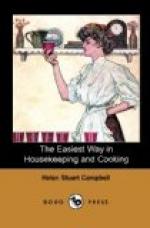TOAST, DRY OR BUTTERED.
Not one person in a hundred makes good toast; yet nothing can be simpler. Cut the slices of bread evenly, and rather thin. If a wire toaster is used, several can be done at once. Hold just far enough from the fire to brown nicely; and turn often, that there may be no scorching. Toast to an even, golden brown. No rule will secure this, and only experience and care will teach one just what degree of heat will do it. If to be buttered dry, butter each slice evenly as taken from the fire, and pile on a hot plate. If served without butter, either send to table in a toast-rack, or, if on a plate, do not pile together, but let the slices touch as little as possible, that they may not steam and lose crispness.
WATER TOAST.
Have a pan of boiling hot, well-salted water; a teaspoonful to a quart being the invariable rule. Dip each slice of toast quickly into this. It must not be wet, but only moistened. Butter, and pile on a hot plate. Poached eggs and minces are served on this form of toast, which is also nice with fricasseed chicken.
MILK TOAST.
Scald a quart of milk in a double boiler, and thicken it with two even tablespoonfuls of corn-starch dissolved in a little cold water, or the same amount of flour. Add a teaspoonful of salt, and a heaping tablespoonful of butter. Have ready a dozen slices of water toast, which, unless wanted quite rich, needs no butter. Pour the thickened milk into a pan, that each slice may be easily dipped into it, and pile them when dipped in a deep dish, pouring the rest of the milk over them. Serve very hot. Cream is sometimes used instead of milk, in which case no thickening is put in, and only a pint heated with a saltspoonful of salt.
* * * * *
TEA, COFFEE, ETC.
For these a cardinal rule has already been given in Part I., but can not be enforced too often; viz., the necessity of fresh water boiled, and used as soon as it boils, that the gases which give it character and sparkle may not have had time to escape. Tea and coffee both should be kept from the air, but the former even more carefully than the latter, as the delicate flavor evaporates more quickly.
TEA.
To begin with, never use a tin teapot if an earthen one is obtainable. An even teaspoonful of dry tea is the usual allowance for a person. Scald the teapot with a little boiling water, and pour it off. Put in the tea, and pour on not over a cup of boiling water, letting it stand a minute or two for the leaves to swell. Then fill with the needed amount of water still boiling, this being about a small cupful to a person. Cover closely, and let it stand five minutes. Ten will be required for English breakfast tea, but never boil either, above all in a tin pot. Boiling liberates the tannic acid of the tea, which acts upon the tin, making a compound bitter and metallic in taste, and unfit for human stomachs.




